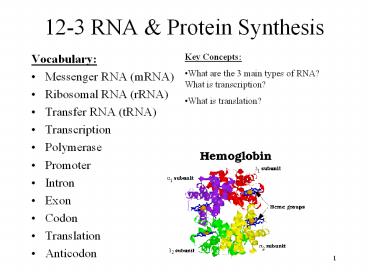12-3 RNA - PowerPoint PPT Presentation
Title:
12-3 RNA
Description:
12-3 RNA & Protein Synthesis Vocabulary: Messenger RNA (mRNA) Ribosomal RNA (rRNA) Transfer RNA (tRNA) Transcription Polymerase Promoter Intron Exon Codon – PowerPoint PPT presentation
Number of Views:137
Avg rating:3.0/5.0
Title: 12-3 RNA
1
12-3 RNA Protein Synthesis
- Vocabulary
- Messenger RNA (mRNA)
- Ribosomal RNA (rRNA)
- Transfer RNA (tRNA)
- Transcription
- Polymerase
- Promoter
- Intron
- Exon
- Codon
- Translation
- Anticodon
- Key Concepts
- What are the 3 main types of RNA?What is
transcription? - What is translation?
2
What do proteins do for the body?
- Proteins are diverse!
- They control chemical messages in cell direct
the synthesis of carbos, lipids, and
nucleotides enzymes give the cell structure and
movement - Goal of protein synthesis MAKE A PROTEIN
3
RNA
- Like DNA made of nucleotides
- disposable copy of DNA segment
- 3 main types mRNA, rRNA, tRNA
- 3 differences
- 1) sugar ribose
- 2) single stranded
- 3) instead of the base thymine (T), RNA uses
uracil (U)
4
Job of RNA Function in Protein Synthesis
5
Transcription
- Step 1 (of 2) of protein synthesis
- Transcribe to make a copy
- transcribing DNA information (gene instructions)
into mRNA which can leave the nucleus and go to
the ribosomes in the cytoplasm - messenger RNA mRNA (1 type of RNA)
- special base sequences in DNA are recognized by
RNA as start and stop signals - Start sequence called promoter region of DNA
6
Details of the Process
- 1. RNA polymerase attaches to DNA at the site
where instructions for the needed protein begins
it separates the 2 DNA strands
7
- 2. RNA polymerase synthesizes the mRNA strand
using complimentary base-pairing
8
- Rememberthere arent T bases in RNA
- C binds with G
- DNA A binds with RNA U
9
A
B
Which strand was copied? A or B
10
- 3. when RNA polymerase reaches the end or "STOP"
part of the genetic code for that protein, it
releases - 4. DNA re-zips
- 5. finished mRNA (message) leaves the nucleus
and goes to a ribosome in the cytoplasm
11
- Bases are grouped by 3
- Called a codon (code)
12
Transcription
Translation
13
- Transcription ends with mRNA which will exit the
nucleus to the cytoplasm - So if Transcription is the first step of Protein
Synthesis, what happens next in the cytoplasm?
14
TRANSLATION
- Making a protein (string of amino acids)
translating from the language of nucleic acids
into a polypeptide - How does it go from mRNA (copy of DNA) to amino
acids (building blocks of proteins)? - A group of 3 mRNA bases makes up a codon (think
of as a code word) - each codon specifies a particular amino acid
- there are start and stop codons
15
The Mechanism...
- mRNA attaches onto the ribosome
- 3 nucleotides of mRNA codon
- 2nd kind of RNA ribosomal RNA (rRNA)
- makes up the majority of the ribosome
16
The Mechanism continued...
- 3rd kind of RNA transfer RNA (tRNA)
- carries amino acids to the ribosomes (amino acids
join together) - there are 64 different tRNA molecules (more
than 1 for each amino acid) - REDUNDANCY of the CODE!!
- 3 nucleotides of tRNA that match or compliment
the mRNA anticodon
17
tRNA
Amino acid
tRNA anticodon
mRNA codon
18
amino acid
tRNA
anticodon
codon (mRNA)
19
The Mechanism continued...
- By matching the codon of mRNA to the anticodon of
tRNA, the correct amino acid is put into place
Next tRNA goes here!!!!
20
The Mechanism continued...
- a peptide bond is formed between the 2 amino
acids
21
The Mechanism continued...
- protein chain continues to grow until a stop
codon is reached on the mRNA - no tRNA exists for stop codons
22
The end of the Mechanism...
- the protein is now finished released!!
23
(No Transcript)
24
Translation All At Once
25
PROTEIN SYNTHESIS All At Once
26
PROTEIN SYNTHESIS
DNA
Step 1. TRANSCIPTION (nucleus)
mRNA
Step 2. TRANSLATION (ribosome)
tRNA
PROTEIN
27
Protein Synthesis
the whole
process
28
Protein Synthesisvideo
http//www.sciencenetlinks.com/interactives/protei
n.html































